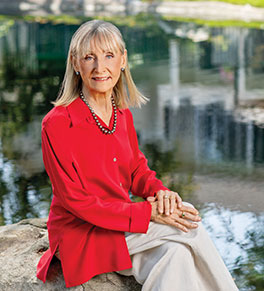TAVR to the rescue

Janice Plastino’s heart was racing, but she was used to that. Diagnosed with a heart murmur at age 6, she began experiencing heart palpitations about 30 years ago. Once, when they became severe and unrelenting, the UC Irvine dance professor was rushed to a campus medical office where she was treated by Dr. Andrew R. Reikes.
The UCI Health internist and endocrinologist helped manage her heart condition successfully for over 25 years until recent tests showed the damage had become life-threatening. Plastino, now in her 80s, would have been out of options not all that long ago.
But the UCI Health Structural Heart Disease Program team performed a minimally invasive procedure called transcatheter aortic valve replacement (TAVR) that has her back to daily walks, cooking and gardening.
It is a game-changer for older patients like Plastino with deadly heart valve problems who cannot undergo open heart surgery, according to Dr. Antonio Halais Frangieh, the UCI Health interventional cardiologist who performed the procedure.
"Today, TAVR is the therapy we offer most of our patients with symptomatic aortic valve stenosis who are over age 65," says Frangieh.
Relying on medication
In the decades before opting for TAVR, Plastino took medication or her condition and underwent annual monitoring tests. Occasionally she felt her heart racing, but that didn’t stop her from enjoying a long career as a dancer, choreographer and researcher.
She was among the founding faculty members of the UC Irvine Department of Dance, eventually becoming a professor and one of the first in academia to conduct dance injury prevention research. She also co-authored a seminal book on the creative and technical aspects of modern dance.
But at her annual check-up in December 2022, she learned that her aortic valve had narrowed so much that it no longer functioned well. Reikes told her that she needed a valve replacement and that Frangieh was the perfect choice to do it.
Explaining TAVR
When Plastino met with the interventional cardiologist, he explained the TAVR procedure, which involves inserting a catheter (a thin, hollow tube) into a blood vessel in her groin and threading it through the arteries to the heart. Once in place, an artificial valve compressed like a folded umbrella in the catheter, is placed inside the faulty valve, where it springs open to strengthen to damaged valve and allow blood to flow normally.
Next, she met with the team, a multidisciplinary group of interventional cardiologists, cardiothoracic surgeons, specialists in heart imaging and anesthesiology. Together, they assessed her case and developed a treatment plan. They agreed that she was an ideal candidate for TAVR.
“What we do goes beyond the procedure itself,” Frangieh says. “It’s the assessment, planning and selection of the procedure, plus performing it in the best setting that ensures the best outcome.”
'Zap, done, finished'
In January 2023, after a preliminary test confirmed that her heart and vascular anatomy was compatible with TAVR, Plastinio arrived at UCI Medical Center for the early morning procedure and went home the next afternoon.
“It was like zap, done, finished,” she recalls. “I had some pain in the groin for one night but that was it. The team was fabulous. They’re clearly experts who know what they’re doing. And they’re so personable.”
TAVR is now performed on a much broader range of patients today than when it was first approved in the United States in 2011.
“With cumulative experience, the operation has evolved, and the technology has improved too,” Frangieh says. “Today’s valve and delivery system is way more advanced in terms of engineering and design, making the procedure even safer and more efficient.”
Plastino marvels at how a major heart procedure could be such a non-event. “My friend had a valve replaced 10 years ago and they had to open him up three times in a four-day period to fix all the problems,” she says. “He almost died and it took him forever to recuperate.”
Quick recovery
Her friends didn’t realize she’d had heart surgery because she returned to her regular activities so quickly. She putters in the garden and makes dinner daily for her husband, Richard, who still works full time at the family business. She also walks 2 miles a day, often with the couple’s new puppy, and loves spending time with their daughter and her family.
Nearly two years after her surgery, Plastino, now 85, gets cardiology checkups every six months. She no longer feels her heart fluttering out of control.
“I’m so happy to be here and to watch my family thrive,” she says.
She recommends the TAVR procedure and Frangieh for anyone experiencing heart valve issues.
“It’s simple, straightforward, done and out,” she says. “The longer someone hesitates, the worse their condition will get. I would probably be dead by now without this intervention.”
Related stories
- Veteran defeats heart valve disease at 101 ›
- 4 tips to improving heart health ›
- Are you having a heart attack? ›
- UCI Health earns American Heart Association heart failure award ›
Explore further
Browse more blog posts by topic.




